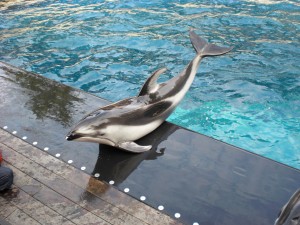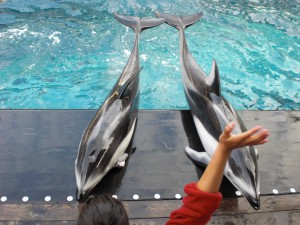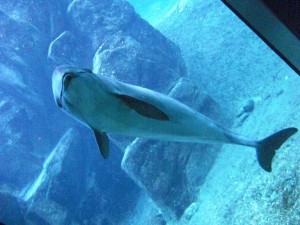3. Vancouver Aquarium Dolphins
Vancouver Aquarium Cetaceans
The Vancouver Aquarium has had a long history of keeping captive cetaceans, starting with the first captive killer whale study with Moby Doll in 1964. The Aquarium has held captive cetaceans of various kinds (primarily orcas and pacific white sided dolphins) ever since this time. Research on captive orcas, done by the Vancouver Aquarium and other facilities, has helped change public perception of orcas from monsterous “killer whales” to charismatic and intelligent creatures. In 1975 the Vancouver Aquarium became the first aquarium in North America to receive AZA accreditation, which it has maintained to this day, along with CAZA accreditation. The Aquarium has not had success in captive breeding of dolphins or orcas, but the lifespans of the animals kept has tended to increase as care and knowledge developed over the years. In 1996 with the introduction of the Vancouver Park By-Law against cetacean capture, the Aquarium announces will no longer capture dolphins from the wild or cause them to be captured. In 2001, the last orca held at the Aquarium was transferred to SeaWorld after the Aquarium determined it did not have the facility space to properly house this species. Since then, the only dolphin species to be kept in the Vancouver Aquarium has been Pacific White Sided Dolphins, with 5 individuals in total residing there since 2001. Of these 5, 2 dolphins remain, with the most recent loss being Spinnaker, a 25 year old male. Spinnaker had been rescued in 1991 after being caught in a fixed fishing net in Japan. Spinnaker was deemed non releasable after intensive rehabilitation. He came to the Vancouver Aquarium in 2001 to join Whitewings, another Pacific White Sided Dolphin held at the time. He had been suffering from an extended illness, and had been receiving extensive veterinary care and monitoring. His death was unexpected due to signs that his health had been improving, which was later confirmed from the necropsy. Spinnaker’s death was a result of a sudden stroke like event. The previous two dolphins that passed away at the aquarium were 36 and 31 years old, some of the longest lived individuals of this species in a captive setting.
The two dolphins that remain at the Vancouver Aquarium are Hana and Helen, who were both transferred from a Japanese aquarium in 2005. Both of these dolphins were rescued from fishing nets much like Spinnaker was. Helen is the older of the two, approximately 24 years old, and Hana is approximately 17. Both dolphins have scars left from their entanglement, and Helen has shortened pectoral fins due to amputation following her injuries. Hana has had 2 pregnancies at the Aquarium and both times has miscarried.
In 2008 a Harbour Porpoise was rescued by the Marine Mammal Rescue centre after being abandoned at approximately 1 month of age. At the time of rescue, the harbour porpoise (named Daisy) was so
weak and emaciated that she couldn’t hold herself up in the water to be able to breathe, requiring 24 care from MMR staff. After countless hours by staff and volunteers, Daisy was well enough to be transferred to the aquarium, where she will remain as she was deemed non-releasable by the DFO because she never learned how to survive in the wild. A practically identical story has occurred with another harbour porpoise, named Jack, who was rescued in 2011 at approximately 6 weeks of age and has since undergone a significant recovery. It remains to be seen what Jack’s fate will entail, but residence at the Aquarium is likely due to the young age at which he was rescued.
All information on this page from the Vancouver Aquarium website, Volunteer Handbook, and personal observations.


